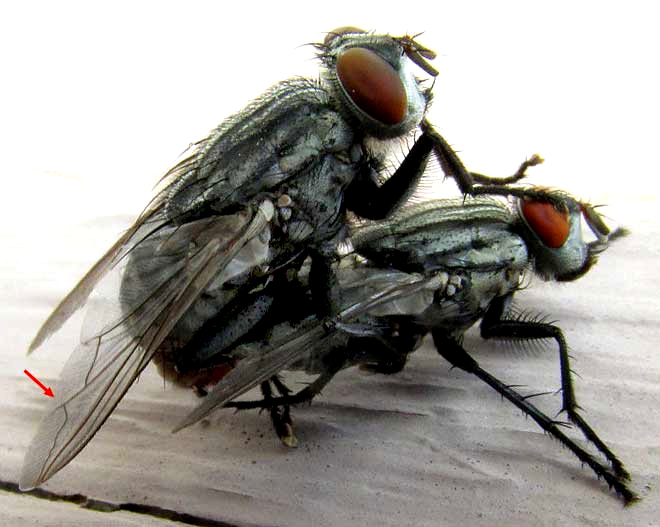Excerpts from Jim Conrad's
Naturalist Newsletter

from the August 17, 2014 Newsletter issued from the Frio Canyon Nature Education Center in the valley of the Dry Frio River in northern Uvalde County, southwestern Texas, on the southern border of the Edwards Plateau; elevation ~1750m (~5750 ft); N29.62°, W99.86°; USA
HOUSEFLY
Early one morning as I arrived at the house I was painting, I noticed a black dot on the house's old, white siding. Thinking it was a nail head needing to be pounded in before I painted, two mating flies almost got smushed before I realized what they were. That's them above.
They looked like houseflies, and they were even on a house, but there's a whole world of flies that look like the species normally called Houseflies. So, were these flies "real" Houseflies? Figuring that out can be more of a challenge than you might think. The Housefly Family, the Muscidae, embraces around 4500 described species worldwide (about 700 in North America) in about 180 genera, and at first glance the vast majority of those species look pretty much like the flies in our picture.
After slogging through all those species comparing technical features, here's my semi-technical advice on how to know whether you have a "real" Housefly, MUSCA DOMESTICA, which, by the way, our black dot on the house siding turned out to be.
The most definitive field mark for the Housefly is the last one. A technical paper describes that point as a "sharp upward bend in the fourth longitudinal wing vein." One common species often misidentified as a Housefly is the Stable Fly, Stomoxys calcitrans, but the vein crossing the same area in its wing is only slightly curved, not pointed like the Housefly's. The Lesser Housefly, Fannia canicularis, also looks very similar and is common, but it is somewhat smaller and its vein in that part of the wing is straight, not at all forming the sharp angle. Around here we have lots of Face Flies, Musca autumnalis, which also are very similar. You might like to look for that sharp angle in the wing of a local Face Fly at http://www.backyardnature.net//n/a/facefly.htm.
It's almost mysterious that Nature should present us with such similar-looking flies who differ so drastically in this single, somewhat obscure feature.
At one time or another all of us hear how Houseflies might fly directly from a pile of dog poop onto the sandwich you're eating, and in so doing deposit onto your food untold numbers of illness-causing microbes. That's true, and it's not encouraging that the Housefly's immature larva, its maggot, spends its days burrowing through decaying garbage, carrion or feces.
A single female Housefly can lay approximately 9,000 eggs in a lifetime. As such, one pair of flies can produce more than 1 million offspring through their offsprings' offspring in a matter of weeks. Obviously, the vast majority of Houseflies must be preyed upon fairly quickly, by spiders, praying mantises, dragonflies, swallows and the like. Therefore, houseflies provide an important service in Nature, and their maggots' lusty conversion of decaying material also is an important role, Houseflies normally live for two weeks to a month.